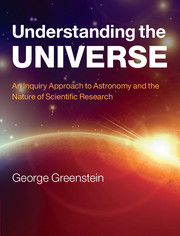Book contents
- Frontmatter
- Contents
- Preface
- Acknowledgments
- Part I Introducing steps to astronomy
- Part II The Solar System
- Part III Introducing stars
- Part IV Introducing galaxies and the Universe
- Epilog
- Appendix I The small-angle formula
- Appendix II Exponential notation
- Appendix III The Solar System
- Appendix IV The closest and brightest stars
- Appendix V Physical and astronomical constants
- Appendix VI Conversion factors
- Appendix VII Constellation maps
- Glossary
- Figure Credits
- Index
- Plate section
Part II - The Solar System
Published online by Cambridge University Press: 05 February 2013
- Frontmatter
- Contents
- Preface
- Acknowledgments
- Part I Introducing steps to astronomy
- Part II The Solar System
- Part III Introducing stars
- Part IV Introducing galaxies and the Universe
- Epilog
- Appendix I The small-angle formula
- Appendix II Exponential notation
- Appendix III The Solar System
- Appendix IV The closest and brightest stars
- Appendix V Physical and astronomical constants
- Appendix VI Conversion factors
- Appendix VII Constellation maps
- Glossary
- Figure Credits
- Index
- Plate section
Summary
The Solar System
The Solar System is our first step outward into the cosmos. It consists of the Sun and the family of bodies orbiting about it. Largest among this family are the planets. Until recently there were nine in all, but in 2006 Pluto was redefined to be no longer a planet. So now there are eight. Mercury is the innermost, and Neptune the outermost planet: our Earth is the third.
Solar System
Sun
Mercury
Venus
Earth
Mars
(Asteroid Belt)
Jupiter
Saturn
Uranus
Neptune
(Pluto)
Orbiting about the planets are the moons. We have one, some planets have none – Mercury and Venus, for example – while others have many – Saturn had more than 60 at last count.
Lying between the orbits of Mars and Jupiter are the asteroids: small, rocky bodies ranging in size from tiny bits of rubble to that of a small moon. Orbiting through the Solar System in highly inclined, highly elliptical orbits are the comets, “dirty snowballs” that vaporize when near the Sun, the vapor streaming away in graceful tails. Also orbiting through the Solar System are the meteoroids, small bodies that occasionally slam into us producing fiery trails in the sky. Some are sufficiently large to survive their passage through the atmosphere and fall to Earth, there to dig craters. When we find them strewn about the ground we have been granted free samples of the cosmos.
- Type
- Chapter
- Information
- Understanding the UniverseAn Inquiry Approach to Astronomy and the Nature of Scientific Research, pp. 159 - 160Publisher: Cambridge University PressPrint publication year: 2013



